My Popup
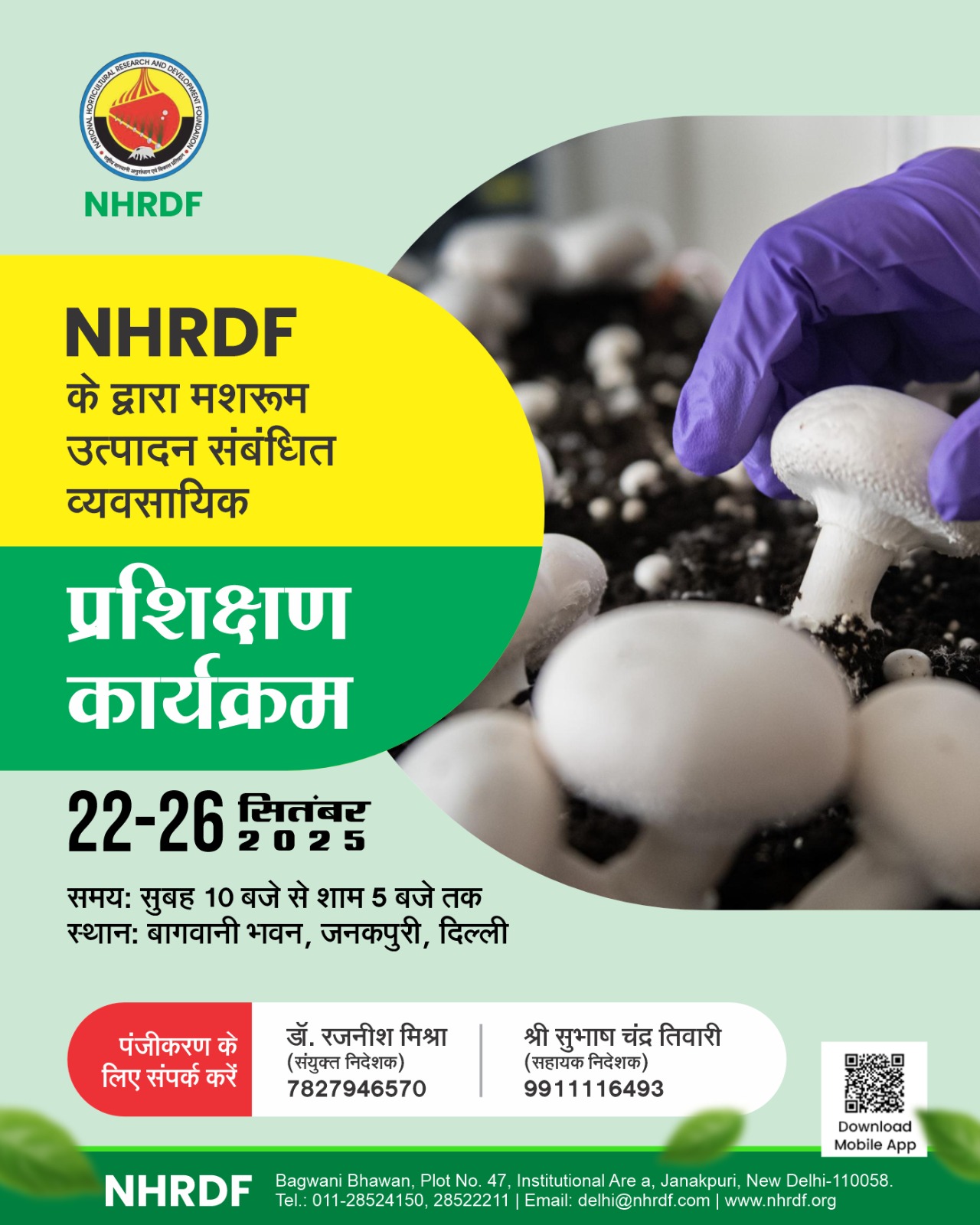

Plant Genetic Resources and Crop Improvement
Onion : (Big)
|
Agrifound Dark Red: Bulbs are dark red,globular round in shape, 4-6 cm in size withtight skin and moderately pungent. Cropmatures in 90-100 days after transplanting. Bulbs contain11-120B total soluble solids, 13-14% dry matter and 10.07 micro mole/g pyruvic acid. The variety gives an averageyield of 300 q/ha. It has been notified by the Govt. of India for growing in kharif season. |
 |
|
Agrifound Light Red: Bulbs are attractive light red, globular round in shape with reddish thickinner scales. Crop matures in 110-120 days after transplanting. Keeping quality of bulbs is good. They contain 130B total soluble solids, 14-15%dry matter and12.20 micro mole/gpyruvic acid.The variety gives an average yield of 300-350 q/ha. It has been notified by the Govt. of India for growing in rabi season. |
 |
|
NHRDF-Red : Bulb are attractive dark red,globularround in shape with reddish thick innerscales. Crop matures in 110-120 days aftertransplanting. Keeping quality of bulbs is medium. They contain13-140B total soluble solids, 14-15% dry matter and 12.0 micro mole/gpyruvic acid. The variety gives an average yield of250-300 q/ha. Ithas been notified by the Govt. of India for cultivation in Northern, Central and Western India in rabi season. |
 |
|
NHRDF-Red-2 : Bulbs are attractive lightred in colour, globular round in shape with thin neck and 5.0-6.0 cm in diameter.Crop matures in 100-120 days after transplanting.Keeping quality of bulbs is good.They contain 13-140B total soluble solids,14-15 % dry matterand12.0 micro mole/g pyruvic acid. The variety gives an average yield of 350-375 q/ha. It has been notified by the Govt. of India for growing in rabi season in zone III (Delhi,Uttar Pradesh, Haryana and Gujarat) and Zone VI (Maharashtra, Karnataka and Andhra Pradesh).
|
 |
|
NHRDF-Red-3 : Bulbs are light bronze in colour,globular round in shape with thin neck and 5.5-6.0 cm in diameter. Crop maturesin 120-130 days aftertransplanting. Keeping qualityof bulbs is good. They contain 12-130B total soluble solids, 13-14% dry matterand 12.50 micro mole/g pyruvic acid.The variety gives an average yield of 350-400 q/ha.It has been recommended for growing in rabi season in Maharashtra, MadhyaPradesh,Gujarat, Delhi, Uttar Pradesh, Bihar, Punjab, Haryanaand Rajasthan.
|
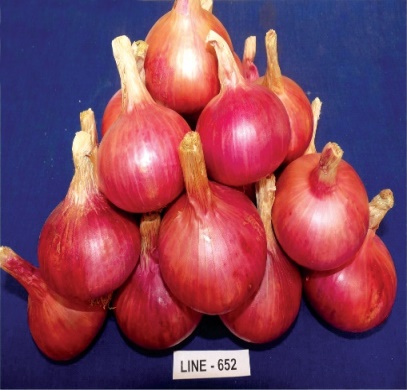 |
|
NHRDF-Red-4 : Bulbs are dark red in colour,globular round in shape with thin neck and 5.5-6.25 cm in diameter. Crop matures in 110-120 days after transplanting. Keeping quality of bulbs is good.They contain 12-140B total soluble solids, 13-14%dry matter and 13.0 micro mole/gpyruvic acid. The variety gives an average yield of 350-400 q/ha. It has been notified by the Govt. of India for growing in rabi season in zone III (Uttar Pradesh, Bihar,West Bengal and Imphal).
|
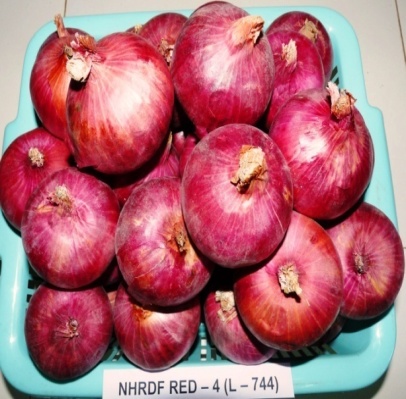 |
|
Agrifound White: Bulbs are attractive white, globularin shape with tight silvery skin.Crop matures in 110-120 days after transplanting.Keeping quality of bulbs is medium to good. They contain 4-15 0Btotal soluble solids, 15-16% dry matter and 12.0 micro mole/g pyruvic acid and are suitable for dehydration. The variety gives an average yield of 250-300 q/ha. It has been recommended for growing in late kharif and rabi seasons in Maharashtra, Madhya Pradesh, Gujarat and Rajasthan. |
 |
|
NHRDF Fursungi: Bulbs are red, round in shape with 5.80 to 6.25 cm in diameter.Cropmatures in 110-120 days after transplanting.The keeping quality of bulbs is good. They contain 12-14 0B total soluble solids and 13-15% dry matter. The variety gives an average yield of 380-400 q/ha. It is toleranttoStemphylium Blight.It has been notified by the Govt. of India for cultivation in Zone-II (Delhi, Rajasthan, Haryana, Jammu & Kashmir & Punjab) and Zone – V (Gujarat &Maharashtra). |
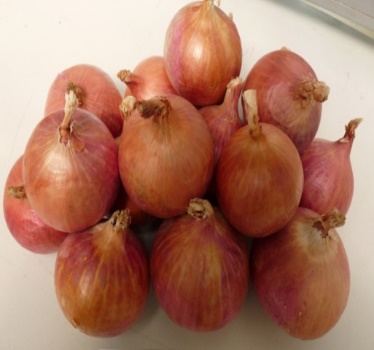 |
|
Onion (Small)
Agrifound Rose: Bulbs are deep scarlet red,flattishround in shape with 2.5-3.5 cm in diameter andare pickling type. Crop matures in 95-110 days aftersowing.They contain 16-18 0B total soluble solids, 17-19% dry matterand10.27 micro mole/g pyruvic acid and aresuitable for dehydration. The variety gives an average yield of 250-300 q/ha. It has been recommended for growing in kharif season in Cuddapah (AP) and in all thethree seasons in Karnataka.
|
 |
|
Onion (Multiplier) Agrifound Red: Bulblets are light red in colourhaving 3.64 cm diameter. The number of bulbletsper cluster is 5-6,each weighing 8.85 g.Crop maturesin 65-67 days after planting. They contain 17-190B total soluble solids, 18-20% dry matter and 10.13 micro mole/g pyruvic acid. It gives an average yield of 180-200 q/ha. It has been recommended for growing in kharif and rabi seasons in zone VIII (Karnataka, Tamil Nadu and Kerala). |
 |
|
Advance Line – 883: Bulbs are darkred in colour with shiny skin, round in shapeand 4.50 – 5.50 cm in diameter. Cropmatures in 85-90 days aftertransplanting. In case of direct seeding maturity comes after 80-85days. Bulbs contain 12-13 0B total soluble solids, 13-14%dry matter and12.0 micro mole/g pyruvic acid. It gives an average yield of 300-325 q/ha.The line is recommended for cultivation in kharif and early kharif seasons all over India. |
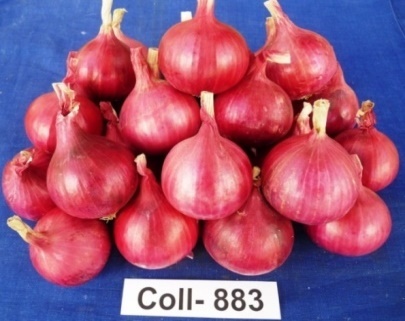 |
|
Advance Line – 863: Bulbs are dark red, round in shapeand4.0-5.5 cm in diameterwith medium keeping quality.They contain 12-130B total soluble solids, 11-12% dry matter and 12.5-13 micro mole/g pyruvic acid.Crop matures in 80-85 days after transplanting.It gives an average yield of 280-300 q/ha. The lineis recommended for cultivation in kharif and Late kharif season. |
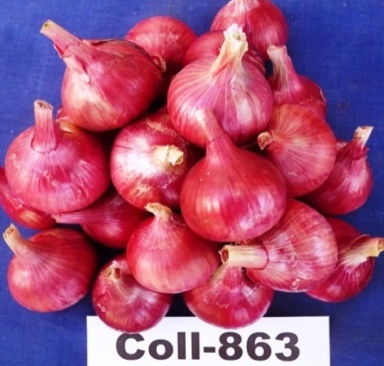 |
Crop Production System Management
To harness the real genetic potential of a variety, the integrated approach in crop production system in terms of plant nutrients, irrigation and weed management is essential. The NHRDF has developed technologies in onion based on consistent research and recommended for adoption to farmers.
To get the quality bulblets (sets), sowing of Agrifound Dark Red seed @ 15-25 g/m2 from 5th to 25th January under Nashik conditions of Maharashtra and 15th to 30th January under Karnal conditions of Harayana are recommended for better germination and higher recovery of acceptable size (1.5 – 2.0 cm.) of bulblets.
The transplanting of 6-7 weeks old seedlings from 15th July and 31st August for kharif crop, 8-9 weeks old seedlings during October-November for late kharif (rangda) crop and December-January for rabi crop at a spacing of 12.5 – 15.0 cm x 10.0 cm have been recommended.
Planting of 1.5-2.0 cm sized bulblets at a spacing of 10.0 x 10.0 cm on Broad Based Furows system is recommended in kharif season for early crop. The use of Cytozyme @ 0.2 % as root dip before transplanting followed by foliar application of the same at 15 and 45 days after transplanting is recommended for higher yield during rabi, as well as kharif.
Foliar spray of water soluble fertilizers (specialty fertilizers) NPK-19:19:19 + 6TE @ 1 % at 15,30 and 45 days after transplanting followed by NPK-13:0:45 @ 1 % at 60,75 and 90 days after transplanting are recommended for getting quality bulb and higher yield. The foliar application of Zinc @ 3ppm + Copper @ 1ppm + Boron @ 0.5 ppm are recommended for enhancement of plant growth, bulb yield and quality. The foliar application of wettable sulphur @ 1 % at 15, 30, 45 and 60 days after transplanting are recommended for higher bulb yield with less disease and pest load.
Application of elemental sulphur @ 30 Kg/ha is recommended for bulb yield whill the use of gypsum @ 45 Kg/ha is recommended for this improvement quality in terms of TSS and dusmatter under Nashik conditions of Maharashtra. Under Karnal conditions of Haryana use of elemental sulphur @ 45 Kg/ha is recommended for higher yield.
Application of NPKS @ 100:50:50:30 K + FYM @ 20t + Azotabactor @ 5 Kg + PSB @ 5 Kg per ha is recommended for higher bulb yield under Nashik conditions of Maharashtra. Under integrated mutrient management.
Use of Pendimethalin @ 3.5 l/ha or Oxyfluorfen @ 0.15 Kg. a.i/ha at 3 days after transplanting are recommended for effective weed control in onion alongwith one handweeding at 25-30 days after transplanting in kharif crop and 40-45 Days After Planting in rabi crop. The use of rice straw mulch or wheat straw mulch during rabi season is recommended to enhance the yield also.
The combined application of Oxyfluorfen 23.5 % EC @ 1ml/l + quizalofop ethyl 5 % EC @ 2 ml/L at 20-25 days after transplanting (DAT) and having at 30-35 DAT gave good confort of weech and higher bulb yield.
The combined application of Oxyfluorfen 23.5 % EC @ 0.75ml/l + quizalofop ethyl 5 % GC @ 125 ml/l before p counting and second application at 30 DAT gave higher bulb yield and need control.
The irrigation of field at 4 to 8 hours before transplanting is recommended during kharif season under Karnal conditions of Haryana for better establishment of seedling and higher bulb yield. The irrigation at 1.25 CPE (Irrigation Depth/Cumulative Pan Evaporation) is recommended for higher yield during rabi season. The drip irrigation enhances the yield and quality of bulbs in onion and thus recommended to farmers.
The drip irrigation for one hour daily or 2-3 at alternate days is recommended under Nashik conditions of Maharashtra for higher yield.
Plant Health Management
Damping off disease of onion nursery
Soil solarization using 250 guage transparent polythene for 25 days followed by soil treatment with Trichoderma viride/T.harzianum @ 5 kg/ha or Thiram @ 5g/m2 in nursery beds and seed treatment with T. viride/T.harzianum @ 5 g/kg or Thiram @ 2.5g/kg seed is recommended for effective control of damping off disease in nursery.
Foliar diseases of onion
Mancozeb (Dithane M-45) @ 0.25% Chlorothalonil (Kavach) @ 0.2 % or Propineb (Antracol) @ 0.2 % with sticker sandovit @ 0.06% sprayed at 10 days intervals or four sprays of Mancozeb @ 0.25%+Monocrotophos @ 0.05% is recommended to control the purple blotch (Alternaria porri) and stemphylium blight (Stemphylium vesicarium). Carbendazim (Bavistin) @ 0.1 % (1.0g/L of water) or Benlet @ 0.1 % followed by Dithane Z-78 @ 0.2 % with sticker sandovit @ 0.06% sprayed at 10 days intervals effectively control the colletotrichum blight or twister disease (Colletotrichum gloesporioides).
The sequential spray of fungicides in combination with insecticides (Mancozeb @ 0.25% methomyl @ 0.8 g/l, propiconazale @ 0.1% + conbosulfom @ 2ml/l, copperoxyahlorids @ 0.25% + profanes @ 1ml/l) at is days interval is recommended to reduce the disease intensity and enhanced the bulb yield under Nashik condition of Maharashtra while under Karnal conditions of Haryana, sequential sprays of mancozeb @ 0.25% + methomyl @ 0.8g/l, trytydazola @ 0.1% + conbosulfam @2ml/l huxaconazole @ 0.1% + profmas @ 1ml/l at 15 days interval is recommended for reducing the disease and increasing the bulb yield.
Bulb rot
Spraying of Streptocycline @ 0.02% (200 ppm) at 10-15 days before harvesting is recommended for the control of bacterial brown rot in onion. Application of Trichoderma viride/T.harzianum @ 5 kg/ha or Pseudomonas fluorescens @ 5kg/ha in the soil before planting of seedlings is recommended for the management of basal rot (Fusarium oxysporum) and white rot (Sclerotium rolfsii) of onion.
Foliar diseases of onion seed crop
Six sprays of Mancozeb @ 0.25% + Monocrotophos @ 0.05% at 15 days intervals proved best for the control of purple blotch and stemphylium blight as well as thrips in onion seed crop. Bulb dip in copper oxyehlride @ 0.3% and drenching of copper oxyehlride @ 0.3% at 30 DAP and falion sprays of conbudazim @ 0.1% at 60 DAP, propriconazde @ 0.1% at 75 DAP and mancozeb @ 0.25% at 90 DAP is recommended for reducing bulb ratios and higher seed yield.
Management of thrips
Nursery: - The spray of deltamethrin 2.8% EC @ 0.095% reduced the thrips population in onion nuesery.
Onion bulb crop: - Foliar sprays of profenofos 50% EC @ 0.1% at 15 days interval (4 sprays) or 3 sprays of fipronil 5% SC @ 0.15% at 15 days interval or 4 spray of deltamethrin 2.8 EC @ 0.095% at 15 days interval or 6 sprays of spinosad 45% SC @ 0.1% at weekly interval along with sticker @ 0.06% considerably reduced the thrips population and increased the yield. Transplanting of onion with border of maize and one line in center in plot size of 3.6m x 1.8m performed better in minimizing thrips population and giving higher yield in Karnal area of Haryana.
The sequential spray of insecticides vig. acetamitrid @ 0.01%, alfamethrin @ 0.15%, combosulfam @ 0.2%, fipronil @ 0.1% is recommended at Nashik while earbosalfan @ 0.2%, lambdacyhalothrin @ 0.15%, aectarnilrid @ 0.01%, alfamethrin @ 0.15% controlling trips population and higher yield of bulbs is recommended for
Onion seed crop: - Drenching of chloropyriphos in soil, control the onion maggots. Spray of deltamethrin 2.8% EC @ 0.095% or Fipronil 5% EC @ 0.1% before flowering of onion and spray of spinosad 45% EC @ 0.1% or Azadirachtin 1500 ppm @ 5 ml / litre recommended for controlling thrips population as well as in managing borers.
Post Harvesting Technology
Post harvest losses in onion and garlic are remarkable which could be reduced considerably by adopting appropriate post-harvest management practices. The NHRDF has developed technologies for bringing down the losses in onion as well as garlic.
Withholding irrigation at 10 – 15 days before harvesting and harvesting at one week after 50% top fall are recommended to reduce post – harvest losses in onion. Application of Maleic Hydrazide @ 2000-2500 ppm is recommended to reduce storage losses during kharif season. Windrow curing of bulbs till complete drying of tops (foliage) and cutting of tops leaving 2.5 cm neck above the bulbs followed by shade curing for 10-15 days before storage reduces the losses and recommended to the farmers. Artificial curing of onion bulbs in curing chamber with full load at 350C temperature and velocity of air flow at 3.2m/s cured the bulbs in 16 hours and recommended for adaptation to farmers.
The improved onion storage structures designed and developed by NHRDF having ventilation from all sides including bottom are recommended for adaptation to reduce post harvest losses. These structures are of 5,10,20,25 and 50 MT capacity suitable for farmers to hold stocks and avoid distress sale. The 5 ton capacity godown is single tier structure have 3.75 m length and 1.5 m with 2 cubicles of 1.88 x 1.5 x 1.5 m size, while 10 t capacity structure have 7.5 m length and 1.5 m with 4 cubicles of 1.88 x 1.5 x 1.5 m size suitable for farmers cultivating less than one acre area and one acre area, respectively. The 15 ton capacity godown is also single row structure with 6 cubicles having 11.25 cm length and 1.5 m width while 20 ton capacity godown is double row structure with passage of 1.2 m between 2 rows to facilitate filling and unloading of bulbs and also sufficient aeration from all sides. These godowns are suitable for farmers cultivating onion on 2 acre and 1 hectare area, respectively. The 25 MT capacity structure is of more permanent nature, suitable for medium farmers and onion storage is done in cubicles arranged in 2 rows with 1.2 m wide passage between 2 rows, however, as most of the farmers cultivate onion in more than one hectare area, 50 ton capacity structures are more popular, which has two rows structure with 1.2 m wide passage between 2 rows and have total length of 18.75 m, width 1.25 m where piling height is maintain for better storage of bulbs.
Seed Technology
Highest seed yield was obtained when 4.5 to 6.5 cm diameter bulbs were planted on 15th October at the spacing of 30 cm x 30 cm at Karnal whereas at Nashik 20th October planting was found best and economical. Dipping onion bulbs in 1% potassium nitrate and 0.1% Carbendazim before planting for seed crop in kharif season and dipping in 0.1% Carbendazim in rabi season are effective for getting higher seed yield. Drip irrigation with wheat or paddy straw mulching has been recommended for effective weed management and getting higher seed yield. Irrigation interval of 10 days throughout the cropping period or 12 days up to 60 days and at 8 days after 60 days and nitrogen @ 80-120 kg ha-1 gave highest seed yield of onion variety Agrifound Dark Red at Nashik. Nitrogen 80 kg ha-1 and irrigation frequency at ten days interval gave highest seed yield of onion variety Agrifound Light Red. Nitrogen 100 -120 kg ha-1 and 30 cm x 30 cm spacing recommended for highest seed yield of Agrifound Dark Red variety of onion under Sinnar, Nashik (Maharashtra) condition. Weedicide Pendimethalin @ 3.5 lit ha-1 + one hand weeding at 45 days gave good control of weeds and maximum seed yield of onion variety Agrifound Light Red under Sinnar (Nashik) condition. Organic package of FYM @ 50 t ha-1 or vermicompost @ 3 t ha-1 + Neem cake @ 1t ha-1 + T. viride @ 2500 g ha-1 before planting + Azotobactor @ 12.5g ha-1 + PSB @ 12.5 kg ha-1 + Yorker (Pacelomyes) @ 125 kg ha-1 at planting and spraying of Azadirachtin @ 0.15% at 15,30,60290 DAP and T. viride at 45, 75 and 105 days after planting can be used for seed production of onion variety Agrifound Dark Red and Agrifound Light Red under Nashik conditions of Maharashtra. Spraying of sodium phosphate @ 50 ppm at 30, 45 and 60 days after planting of Agrifound Light Red seed crop increased seed yield by 37 % at Nashik. Use of paddy straws as mulch in seed crop with drip irrigation increases seed yield by 42 % in onion Agrifound Dark Red with higher net return.
Hydration and dehydration treatments have been recommended for increasing the germination in onion seed. Onion Agrifound Dark Red seed coated with DAP+ZnS04+Bavistin as well as with DAP + Borax +Trichoderma and sown in July and harvesting in November gives highest gross yield (150.0 q/ha). Priming of onion seed of variety Agrifound Dark Red with 200 ppm potassium dihydrogen orthophosphate enhanced the germination percentage upto 20 days after priming and reduced thereafter during kharif season.